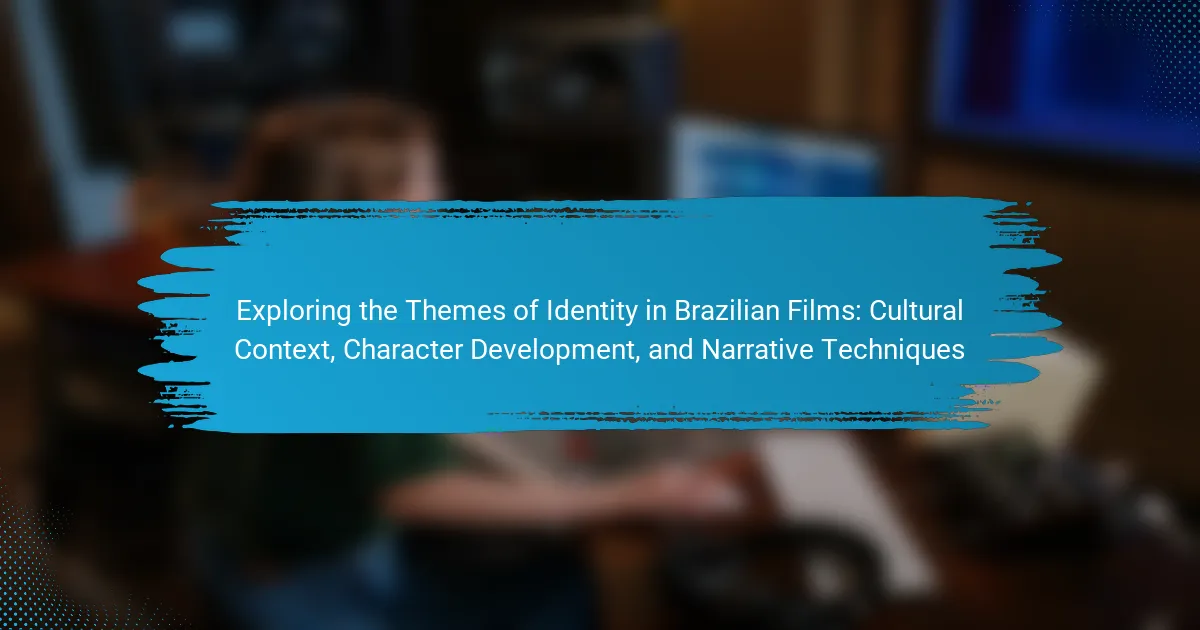The article examines the themes of identity in Brazilian films, focusing on the critical aspects of race, class, and cultural heritage. It highlights how Brazilian cinema portrays the complexities of racial identity, particularly through the experiences of Afro-Brazilian characters, while also addressing the socioeconomic divides that influence individual narratives. Additionally, the significance of cultural heritage is explored, showcasing how films celebrate indigenous and regional identities. Notable examples such as “City of God” and “Central Station” illustrate the intersection of personal and collective identity, contributing to a nuanced understanding of Brazilian society and its diverse cultural fabric.

What are the key themes of identity explored in Brazilian films?
Key themes of identity explored in Brazilian films include race, class, and cultural heritage. Brazilian cinema often reflects the complexities of racial identity, showcasing the struggles and triumphs of Afro-Brazilian characters. Class disparity is another prevalent theme, highlighting the socioeconomic divides that shape individual experiences. Cultural heritage plays a significant role, with films often celebrating indigenous and regional identities. These themes are evident in films such as “City of God” and “Central Station,” which address the intersection of personal and collective identity. The exploration of these themes contributes to a deeper understanding of Brazilian society and its diverse fabric.
How do cultural contexts influence the portrayal of identity in Brazilian cinema?
Cultural contexts significantly influence the portrayal of identity in Brazilian cinema. Brazilian films often reflect the country’s diverse cultural heritage. This includes influences from Indigenous, African, and European cultures. These influences shape character development and narrative techniques. For instance, films like “City of God” showcase the complexities of life in favelas. They depict socio-economic disparities and cultural identities. Additionally, the historical context of Brazil, including its colonial past, affects storytelling. This results in a rich tapestry of narratives that explore identity. Overall, Brazilian cinema serves as a mirror to its cultural contexts, revealing the multifaceted nature of identity.
What historical events shape the identity themes in Brazilian films?
Brazilian films are shaped by several key historical events. The military dictatorship from 1964 to 1985 significantly influenced cinematic expression. This period led to censorship and repression, which filmmakers responded to with subversive narratives. The end of the dictatorship marked a resurgence of creative freedom. The economic crises in the 1980s also impacted film production and themes. The rise of the Brazilian cinema movement in the 1990s highlighted social inequalities. Additionally, the Afro-Brazilian cultural renaissance has influenced identity representation in film. These events collectively inform the portrayal of Brazilian identity in cinema.
How do social dynamics affect character identities in Brazilian narratives?
Social dynamics significantly influence character identities in Brazilian narratives. These narratives often reflect the complexities of Brazilian society, including class, race, and regional differences. Characters frequently embody the struggles and aspirations shaped by their social environments. For instance, the portrayal of marginalized communities reveals the impact of socio-economic status on personal identity. Films like “City of God” illustrate how violence and poverty shape the identities of young characters. Furthermore, social dynamics can lead to conflicts that drive character development. The interactions between characters from different backgrounds highlight the tensions and collaborations within Brazilian society. Ultimately, these narratives serve as a mirror to the evolving identities influenced by Brazil’s diverse social landscape.
What role does character development play in expressing identity themes?
Character development plays a crucial role in expressing identity themes. It allows audiences to see the transformation and growth of characters over time. This transformation often reflects the complexities of personal and cultural identities. In Brazilian films, character arcs frequently illustrate struggles with social, racial, and economic identities. For example, films like “City of God” showcase how characters navigate their environments, revealing their identities through choices and relationships. Such narratives highlight the interplay between individual experiences and broader societal issues. This connection between character development and identity themes deepens audience engagement and understanding.
How are protagonists typically portrayed in relation to their identities?
Protagonists in Brazilian films are typically portrayed as complex individuals whose identities are shaped by socio-cultural contexts. Their identities often reflect the struggles and aspirations of Brazilian society. These characters frequently navigate themes of race, class, and gender, which influence their personal journeys. For example, films like “City of God” showcase characters grappling with their socio-economic backgrounds. The portrayal of identity often serves as a critique of societal norms and injustices. This complexity allows audiences to engage with the characters on a deeper emotional level. The exploration of identity in these films highlights the intersectionality of various cultural factors. Overall, protagonists embody the diverse experiences of Brazilian life, making their identities central to the narrative.
What techniques do filmmakers use to depict character growth and identity evolution?
Filmmakers use various techniques to depict character growth and identity evolution. One technique is character arcs, where a character undergoes significant change throughout the narrative. This change often reflects their internal struggles and external challenges. Another technique is visual symbolism, where filmmakers use imagery to represent a character’s emotional state or transformation. Dialogue also plays a crucial role; conversations can reveal a character’s evolving beliefs and values. Flashbacks provide context, showcasing past experiences that shape a character’s identity. Additionally, relationships with other characters can highlight growth, as interactions often influence personal development. The use of music and sound can evoke emotional responses, enhancing the portrayal of a character’s journey.
What narrative techniques are employed to explore identity in Brazilian films?
Brazilian films employ various narrative techniques to explore identity. These techniques include non-linear storytelling, which reflects the complexity of personal and cultural identities. Flashbacks are frequently used to reveal characters’ pasts, shaping their present identities. Additionally, multiple perspectives often provide a broader understanding of identity in different social contexts.
Symbolism plays a significant role, using objects or motifs to represent broader themes of identity. Dialogue often incorporates regional dialects and cultural references, grounding characters in their specific identities. Furthermore, the use of voiceovers allows for internal monologues that express personal struggles with identity.
These techniques collectively create a rich tapestry that illustrates the multifaceted nature of identity in Brazilian society.
How do storytelling structures contribute to identity representation?
Storytelling structures significantly contribute to identity representation by shaping how narratives unfold. They provide frameworks that guide character development and cultural context. For example, linear structures often emphasize personal journeys, allowing audiences to connect with characters’ identities over time. In contrast, non-linear structures can reflect the complexity of identity by presenting fragmented experiences.
These structures also influence audience perception. A well-crafted narrative can evoke empathy and understanding of diverse identities. Research indicates that storytelling techniques, such as flashbacks or parallel narratives, enhance emotional engagement. This engagement fosters a deeper appreciation for cultural nuances and individual experiences.
In Brazilian films, storytelling structures often highlight social issues and cultural heritage. They serve as a vehicle for exploring themes of race, class, and gender. By intertwining personal and collective narratives, these films create a rich tapestry of identity representation. This approach not only reflects the multifaceted nature of identity but also challenges stereotypes and promotes dialogue.
What use of symbolism enhances the themes of identity in these films?
Symbolism in Brazilian films often enhances themes of identity through visual metaphors. For example, the use of color symbolizes different cultural backgrounds. Specific colors can represent social class or regional identity. Objects, such as traditional clothing, signify cultural heritage and personal history. Landscapes in the films can reflect internal struggles of characters. The urban versus rural settings symbolize the clash between modernity and tradition. These symbols create a deeper understanding of the characters’ identities. They also invite viewers to explore their own cultural contexts. This layered use of symbolism enriches the narrative and emotional depth of the films.
How do Brazilian films reflect the complexities of identity in a globalized world?
Brazilian films reflect the complexities of identity in a globalized world by showcasing diverse cultural narratives. They often explore themes of race, class, and gender, highlighting Brazil’s multicultural society. Films like “City of God” depict the socio-economic divides and the impact of globalization on urban life. Characters in these films navigate their identities amidst external pressures and cultural influences. The portrayal of favelas emphasizes the struggle for recognition and belonging. Brazilian cinema also incorporates global cinematic techniques while maintaining local storytelling traditions. These films resonate with international audiences, fostering cross-cultural dialogues. Overall, Brazilian films serve as a mirror to the evolving identities shaped by globalization.
What are the implications of identity themes for audiences and cultural understanding?
Identity themes significantly influence audiences and cultural understanding by shaping perceptions and fostering empathy. These themes provide insight into diverse cultural backgrounds and experiences. They encourage viewers to reflect on their identities and societal roles. For instance, Brazilian films often explore race, class, and gender dynamics. This exploration can challenge stereotypes and promote dialogue among audiences. Research indicates that films addressing identity can enhance cultural awareness and appreciation. According to a study by Lima et al. (2020) in the Journal of Cultural Studies, films that depict complex identities foster greater understanding among viewers. Thus, identity themes in cinema serve as a bridge for cultural exchange and awareness.
How can viewers engage with and interpret identity themes in Brazilian cinema?
Viewers can engage with and interpret identity themes in Brazilian cinema through critical analysis of characters and narratives. Analyzing character backgrounds reveals cultural and social influences shaping their identities. Observing narrative techniques, such as non-linear storytelling, enhances understanding of complex identity formations. Engaging with historical contexts provides insight into societal issues reflected in films. For example, films like “City of God” showcase urban violence and class struggles, prompting discussions on identity. Furthermore, viewers can explore representation of race and gender, as seen in “The Second Mother,” to understand diverse perspectives. This multifaceted approach fosters deeper connections with the themes presented.
What are some recommendations for exploring identity themes in Brazilian films?
To explore identity themes in Brazilian films, consider viewing films like “City of God” and “Central Station.” These films depict urban life and social issues affecting Brazilian identity. Analyze character development to understand how personal backgrounds shape identity. Examine narrative techniques that highlight cultural diversity within Brazil. Look for films that address race, class, and gender to gain a comprehensive view of identity. Research critiques and analyses of these films to deepen your understanding. Engaging with local film festivals can also provide insights into contemporary identity themes.
The main entity of this article is the exploration of identity themes in Brazilian films. The article examines key themes such as race, class, and cultural heritage, highlighting how these elements shape character development and narrative techniques. It discusses the influence of cultural contexts and historical events on identity portrayal, as well as the role of social dynamics and character growth in reflecting Brazilian society. Additionally, the article analyzes how storytelling structures and symbolism enhance the representation of identity, ultimately revealing the implications of these themes for audiences and cultural understanding.
